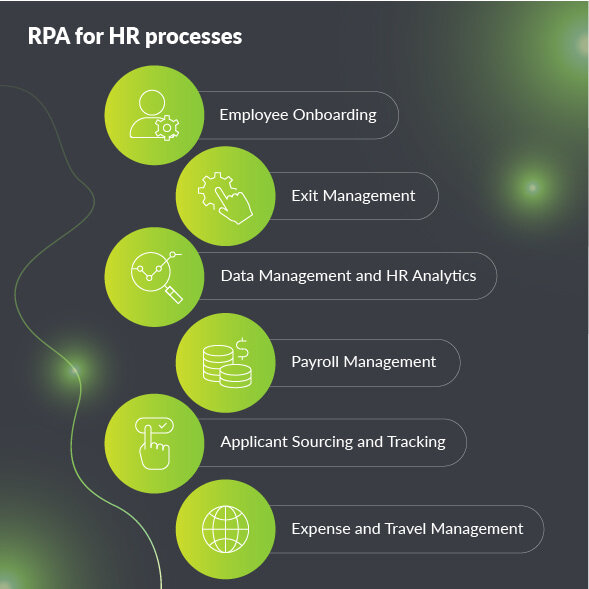How Robotic Process Automation in HR Can Help You Markedly Enhance Your Operations

Technology such as Robotic Process Automation (RPA) is there to open up new opportunities for many organizations and their workers. Organizations are now able to simplify transactional HR work by integrating robotic process automation in their processes. But what are the exact advantages of it? Let’s talk about how RPA can help to amplify a human’s potential to focus on more useful and strategic initiatives. We will go over everything you need to know about RPA in HR, including the real benefits in addition to the use cases.
What Does RPA Bring for the Human Resources Department?
Let’s look at the example: Customers nowadays expect the quickest solutions to their complaints. To provide their customers with the best responses, businesses have to put a lot of effort as well as take some time to recognize each of them. This task is quite mundane and monotonous. But what about the tasks that require more human attention?
Gallup’s State of the Global Workplace survey reveals to us that 87% of workers throughout the world are either not engaged or actively disengaged at work. This ends up costing $7 trillion in lost productivity. The only way to free up more time for critical company operations and engage the employees in better, more innovative ways is to automate the routine processes. That’s how RPA technology is now incorporated in the Human Resources Department. RPA (robotic process automation) is a great method to increase HR data management skills.
What does RPA refer to exactly? RPA refers to software bots that automate rule-based, high-transactional HR procedures with little or no human participation which consequently helps to save up important resources.
RPA tools for HR processes help to save department’s time that can be later used for other serious tasks:
- Taking data-driven actions
- Effective performance management that may enhance staff productivity
- Improve the company’s brand in a competitive employment market
- Using people analytics to keep workers engaged
RPA applications, at their most basic level, allow business users to construct a script, referred to as a bot, that is able to replicate how humans interact with technology. RPA human resources operations are represented by a software robot that can conduct high-volume, repetitive operational activities on behalf of HR workers. This is extremely helpful since these include procedures that involve a considerable amount of manual and repetitive work, such as new employee onboarding, payroll processing, and compliance reporting.
RPA automates these operations by utilizing multiple robots. As a result, a business may have a complete virtual workforce that can handle all of these duties with improved accuracy and efficiency. It’s also important to remember that RPA does not automate jobs, it automates tasks.
According to Duncan Harris, research director of HR technology strategy and management at Gartner, the “robotic” part of RPA is sometimes mistaken for machine learning. The truth is, RPA can’t make decisions unless machine learning is augmented. That’s why the presence of real people is still necessary.

What are the Benefits of RPA in HR? How Can RPA Create a More Human Workplace?
HR departments all over the world use RPA technology. This decision is allowing them to recover up to 40% of their time, while also making their workplaces happier and more human-centric. The concept of human-centric means that businesses may reduce the amount of time their workers spend on dull and repetitive tasks. However, the benefits of RPA in HR are quite significant overall.
The following are the main advantages of RPA in the HR department:
-
Scalability
When used on a broad scale, and scaled up or down according to the system’s demands, RPA has a considerably low cost per effort, resulting in zero or no wasted effort or downtime for the system as a whole.
-
Accuracy
While using RPA, accuracy is guaranteed because of the carefully pre-coded technology. Its superiority, which vastly exceed its human equivalents, allows it to provide exact output and make decisions quickly when it comes to data analytics. The technology immediately adds to the company’s overall strategic goals and productivity by allowing employees to focus on higher-value jobs. Without needing specialists to double-check every field, RPA makes organizational records management compliant and error-free.
-
Consistency
RPA was designed to provide flawless replication and error-free performance, as well as to eliminate output variance over the course of an operating period. They are dependable since they can work 24 hours a day, seven days a week, and do not require sick leave.
-
Flexibility
RPA technologies are incredibly adaptable and can execute pre-programmed tasks regardless of the deployment environment.
-
Payroll expenses are lower
With RPA you will save a lot of time and money. Using these technologies for payroll processing increases efficiency, protects private data and manages finances – all while staying within a tight budget.
-
Better talents
Many businesses are constantly competing over employees that can bring a high value and quality performance. 63% of recruiters state that the talent shortage is one of the biggest problems they are facing these days. Things can turn for the better with RPA. Improving employee experience increases a business’ success when it comes to finding the right talents.

Confirmed Use Cases of RPA for HR Processes
Almost every organization’s HR function has to deal with lots of time-consuming administrative responsibilities. RPA provides businesses and their HR departments with a bunch of straightforward advantages. The following are some of the most important use cases that you should know about:
-
Shortlisting candidates based on their CVs
On average, each corporate job proposal draws 250 resumes at least. When it comes to basic HR functions like recruiting, a lot of effort is spent assessing resumes and application forms provided by candidates for open positions. Software robots gather resumes and compare the data to the exact job criteria. These specifications can be thought of as established rules that influence the entire selection process when using RPA technology. As a result, qualified applicants may receive phone calls notifying them of an interview, while those who do not fulfill the selection criteria may receive rejection messages. RPA technology can also be used by HR managers to cut the quantity of paperwork required in the process.
-
Employee induction and training
During the RPA HR onboarding process of new hires, there is always a hassle. HR specialists genrally manage responsibilities like generating a new user account and email address, as well as granting access to essential data, apps, and IT equipment. RPA technology allows the HR department to entirely automate the induction process.
-
Employee data management
Managing employee data manually can be really stressful for HR departments. It usually involves methodical and consistent activities across many databases, ranging from payroll and employee benefits to company regulations and more. When data is managed by bots, it is compatible across many systems, it is updated on a frequent basis and there is a low danger of incorrect data entry. Data cleansing operations can also be performed by robots on a regular basis to ensure data compatibility across numerous databases.
-
Maintaining compliance of the organization
One of the most critical HR tasks in any business is ensuring compliance. Companies must prioritize error-free and smooth compliance due to strict labor laws and other requirements. However, guaranteeing high compliance at an organizational level needs a significant amount of time and effort on the part of HR specialists, as each and every item must be thoroughly reviewed and entered. Now, because everything is done by software bots, using RPA software for compliance-related operations not only speeds up the process, but also decreases delays and human errors, improving the overall accuracy of the process.
-
Expenses and travel management
The handling of travel and spending is another difficult operation that HR or finance professionals deal with. Due to a variety of problems, such as missing receipts, late expense submissions, out-of-policy spending, and cluttered spreadsheets, managers in any business find it difficult to keep up with the manual operations of travel and cost management.
-
Payroll Processing
Payroll processing is one of those tedious HR procedures businesses can’t do without. Payroll management by hand is prone to various mistakes due to the large volumes of data entry required on a daily basis. Continuously changing tax rules and fast-increasing reporting requirements, as well as technical issues, can make it even more exhausting. Due to its capacity to link data from many systems, RPA human resources can help simplify the process. Furthermore, RPA bots may validate employee hours that have been entered into the system, gather correct data, and eliminate any delays in salary payments to vendors and employees.
Best Practices of RPA Software for HR
If you implement your RPA technology correctly you can achieve the full benefit of its power which will boost your HR team’s productivity. Of course, here comes one of the big questions: what are some of the best practices to try out when you decide to automate your HR processes?
-
Set your expectations and ROI targets
It is critical to focus on the value produced at every step of the process to guarantee that the RPA project provides a favorable ROI. Make sure to establish expectations from the start, specify goals, and design tactics to attain them.
-
Create a model for shared services that is well-defined
Streamline your HR procedures by automating tasks and having a single spot for all of the information to ensure success. RPA allows you to automate all of the manual duties associated with time-consuming HR procedures including onboarding, payroll processing, compensation modifications, and departure management. You’ll save money and have a more efficient HR team as a result of this.
-
To illustrate the success of automation, start with a few selected processes
To fully utilize the immense potential of robots, it is always a good idea to start RPA deployment with chosen HR tasks that are most suited for automation.
-
Instruct your HR staff, stakeholders, leadership, and users on the RPA capabilities
Internal personnel and other stakeholders must be properly trained in order for RPA to be effective. Create a self-service section for workers and employees where they may get answers to any of their questions. Employees would only contact HR with particular problems, allowing you to simplify the HR operations. It will also save up a lot of time for the future and improve the efficiency of HR departments.
To conclude
HR is an easy place to start when it comes to implementing RPA in your company. Robots will assist organizations in streamlining the repetitive processes which can help you save a lot of time. Aside from increasing the accuracy and speed of data processing, RPA may help reduce the total HR expenses. A recent survey performed by Deloitte confirmed RPA is a proven solution. Over 74% of the respondents plan to look closely at the technology in the coming years, and almost 22% of them have already learned how to automate HR processes or fully implement RPA. Assigning your tedious day-to-day work to a robot is a huge advantage that many are striving to try out.
Related Articles
 September 29, 2025
September 29, 2025
Build your team or extend with ours? Here’s what helps fintech CTOs decide
Read the post September 10, 2025
September 10, 2025
Fixed-price projects vs dedicated teams: A fintech CTO comparison
Read the post September 3, 2025
September 3, 2025
How burnout is crippling tech leadership in the Nordics and Benelux
Read the post September 29, 2025
September 29, 2025
Build your team or extend with ours? Here’s what helps fintech CTOs decide
Read the post September 10, 2025
September 10, 2025
Fixed-price projects vs dedicated teams: A fintech CTO comparison
Read the post September 3, 2025
September 3, 2025
How burnout is crippling tech leadership in the Nordics and Benelux
Read the postWrite your own
success story
with Pwrteams!
Share your details in the form, tell us about your needs, and we'll get back with the next steps.
- Build a stable team with a 95.7% retention rate.
- Boost project agility and scalability with quality intact.
- Forget lock-ins, exit fees, or volume commitments.